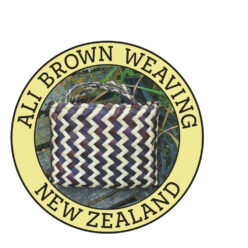30 October 2019
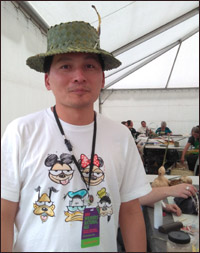 The 2019 Weavers National Hui, held over four days at Labour weekend at Ngā Hau e Whā National marae in Ōtautahi/Christchurch was a terrific success in my view. Thanks go to the organising group including Ranui Ngarimu and Paula Rigby and the many obliging volunteers, who put together a weekend of weaving, knowledge sharing, forums and visits to sites of interest. The delicious food served up by Te Rūnanga o Ngā Maata Waka completed the enjoyable experience.
The 2019 Weavers National Hui, held over four days at Labour weekend at Ngā Hau e Whā National marae in Ōtautahi/Christchurch was a terrific success in my view. Thanks go to the organising group including Ranui Ngarimu and Paula Rigby and the many obliging volunteers, who put together a weekend of weaving, knowledge sharing, forums and visits to sites of interest. The delicious food served up by Te Rūnanga o Ngā Maata Waka completed the enjoyable experience.
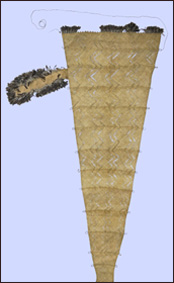 One of the highlights was the presentation of two groups studying Te Ra: The Māori sail, which is the only known Māori sail left in existence and is held by the British Museum. One group is studying the sail from a practical weaver’s approach, working out the weaving techniques used to weave Te Ra. With this knowledge they hope to recreate a traditional sail. At the hui, members of the group were weaving samples using very fine weaving strips. The techniques include open-weave sections that allow the wind through the sails. Follow their progress on Facebook. The other group, looking from a scientific perspective, used a polarised light microscope to compare tiny specimens taken from Te Ra to a set of identified reference materials. They confirmed that the material that Te Ra is made from is actually harakeke, Phormium tenax, that is, New Zealand Flax. Follow their progress here.
One of the highlights was the presentation of two groups studying Te Ra: The Māori sail, which is the only known Māori sail left in existence and is held by the British Museum. One group is studying the sail from a practical weaver’s approach, working out the weaving techniques used to weave Te Ra. With this knowledge they hope to recreate a traditional sail. At the hui, members of the group were weaving samples using very fine weaving strips. The techniques include open-weave sections that allow the wind through the sails. Follow their progress on Facebook. The other group, looking from a scientific perspective, used a polarised light microscope to compare tiny specimens taken from Te Ra to a set of identified reference materials. They confirmed that the material that Te Ra is made from is actually harakeke, Phormium tenax, that is, New Zealand Flax. Follow their progress here.
A large part of the hui was spent sharing basic and advanced weaving ideas and techniques. For example, a kuia showed Chiu, pictured above, how to weave a sun-visor hat, pōtae, and I showed a weaver from Tāmaki-makau-rau/Auckland how to make a neat even finish on the top edge of her first waikawa.
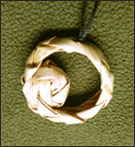 Several people commented on the koru pendant I designed a few years ago and was wearing, so I showed them how it’s made. One kuia was interested to weave this pendant as she was weaving items for tourists and thought the pendant was small and light and is easy to carry in luggage. If you’d like to make one yourself, check out my blog post Weaving jewellery where you’ll find instructions for that pendant and other pendants made using the curved four plait.
Several people commented on the koru pendant I designed a few years ago and was wearing, so I showed them how it’s made. One kuia was interested to weave this pendant as she was weaving items for tourists and thought the pendant was small and light and is easy to carry in luggage. If you’d like to make one yourself, check out my blog post Weaving jewellery where you’ll find instructions for that pendant and other pendants made using the curved four plait.
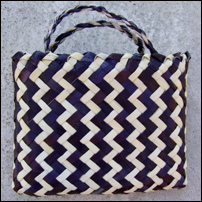 This year, the exhibition at National Hui celebrated the weaver and kete — a kete made by the attendee, or one brought, gifted or inherited. The stunning display of kete in this exhibition showcased the wide variety of designs, patterns and weaving techniques that encompass the weaving of the past and present. I don’t have permission to use images of the ketes in the exhibition, apart from this one which is the first kete whakairo, or patterned kete, I wove many years ago. The pattern is Koeaea and represents whitebait swimming.
This year, the exhibition at National Hui celebrated the weaver and kete — a kete made by the attendee, or one brought, gifted or inherited. The stunning display of kete in this exhibition showcased the wide variety of designs, patterns and weaving techniques that encompass the weaving of the past and present. I don’t have permission to use images of the ketes in the exhibition, apart from this one which is the first kete whakairo, or patterned kete, I wove many years ago. The pattern is Koeaea and represents whitebait swimming.
The National Weavers Hui is held every two years and it’s well worth going to. The next one in 2021 will be held in Ōtaki and I look forward to meeting up with old and new weaving friends there.
My thanks to the ©Trustees of the British Museum for permission to use the image of Te Ra on this post.
© Ali Brown 2019
Scroll down to leave a new comment or view recent comments.
Also, check out earlier comments received on this blog post when it was hosted on my original website.
